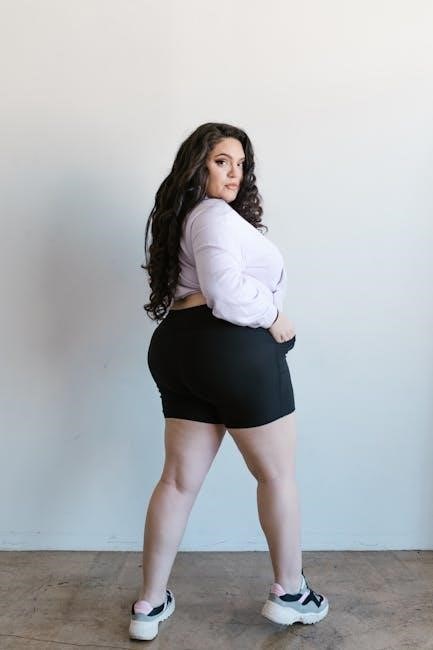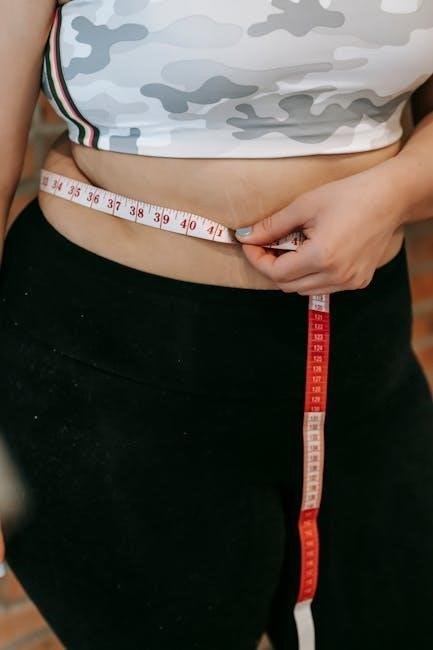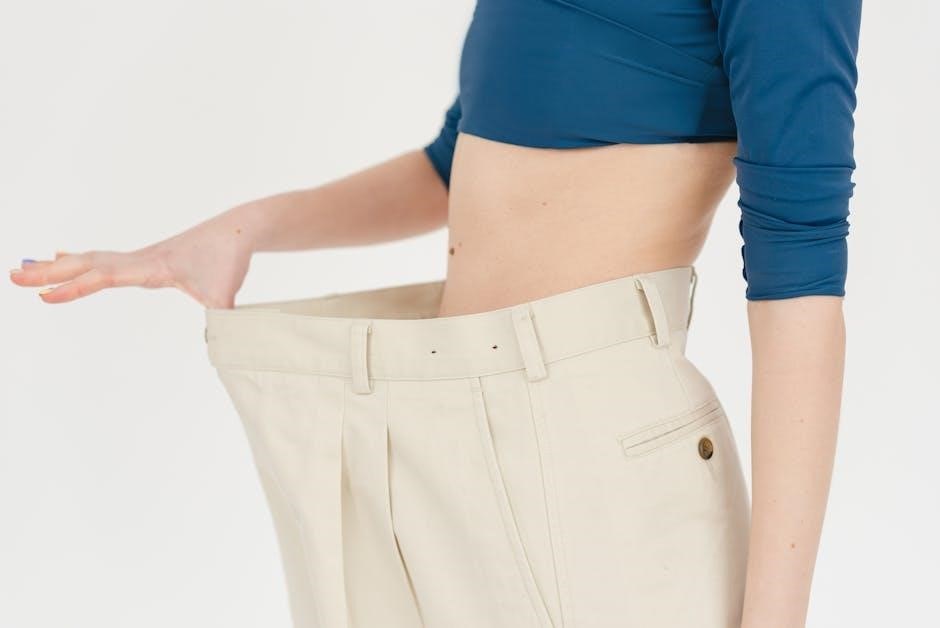Clothing size guides are essential tools to help you find the perfect fit. They provide standard measurements for men and women, ensuring accurate sizing and minimizing purchase mistakes.

How to Measure Your Body for Clothing Sizes
Accurate body measurements are crucial for finding the perfect fit. Start by using a flexible measuring tape placed comfortably, not too tight or loose. For men and women, measure the bust under the arms, around the fullest part. The waist is measured just below the natural waistline, while the hips are measured 8 inches (20 cm) down from the waist. For tops, measure the length from the chest to the natural waistline. For bottoms, measure the inseam from the crotch seam to the ankle bone. Take these measurements in front of a mirror to ensure accuracy. If you’ve recently gained or lost weight, consider adjusting your size accordingly. These measurements will help you match your body proportions to clothing size charts, ensuring a comfortable and flattering fit. Always refer to the specific sizing guide for the brand you’re shopping, as sizes can vary slightly between manufacturers.

Men’s Clothing Size Guide
Mens clothing sizes vary by category, including tops, bottoms, and outerwear. Measurements are based on chest, waist, and inseam to determine the best fit for each garment type.

Mens Tops and Outerwear Size Chart
Mens tops and outerwear sizing is determined by chest measurements. Small sizes typically fit chests measuring 34-36 inches, medium for 38-40 inches, large for 42-44 inches, and extra-large for 46-48 inches. Outerwear, like jackets, may have slightly larger measurements to accommodate layering. Use a flexible tape measure to ensure accurate sizing, and consider fabric type for fit. Some brands offer slim or relaxed fits, so check specific charts for the best match. Always refer to the brand’s size chart, as variations exist between manufacturers. Proper fit ensures comfort and style, whether for casual or formal wear. Purchasing the correct size enhances both appearance and functionality of the garment. Always measure before ordering to avoid discrepancies.
Mens Bottoms Size Chart
Mens bottoms sizing is primarily based on waist and inseam measurements. Waist sizes typically range from 28 to 44 inches, with corresponding pant sizes from 28 (S) to 44 (4XL). Inseam lengths vary from 28 to 34 inches, catering to different heights and styles. Slim-fit pants have a narrower cut, while relaxed fits offer more comfort. Measure your natural waistline and the inside of your leg to determine your size. Use a flexible tape measure for accuracy. Sizes may vary slightly between brands, so always check the specific size chart. Proper fit ensures comfort and style, whether for jeans, trousers, or shorts. Purchasing the correct size enhances both appearance and functionality of the garment. Always measure before ordering to avoid discrepancies.

Women’s Clothing Size Guide
Womens clothing sizes are determined by bust, waist, and hip measurements. Standard sizes range from XS to 4XL, catering to various body types, including petite, misses, and plus sizes.
Always refer to specific size charts for accurate fits, as sizing may vary between brands and styles. This guide helps you choose the perfect size for a flattering fit.
Womens Tops Size Chart
Womens tops size chart provides detailed measurements to ensure a perfect fit. Bust measurements are crucial, ranging from 31.5 inches for XS to 46.5 inches for 4XL. Each size corresponds to specific chest sizes, ensuring comfort and style. Tops are categorized into standard, petite, and plus sizes, catering to diverse body types. Fabric type and design can influence fit, so measuring accurately is key. Refer to the chart to match your bust size with the appropriate size label. This guide helps avoid sizing errors, ensuring your tops are neither too tight nor too loose. Always consider your body type and preferred fit when selecting sizes. By following the chart, you can confidently choose tops that flatter your figure and meet your fashion needs. Accurate measurements ensure a seamless shopping experience, whether online or in-store.
Womens Bottoms Size Chart
The womens bottoms size chart offers a comprehensive guide to finding the perfect fit for pants, skirts, and shorts. Measurements focus on waist and hip sizes, ensuring comfort and style. Waist sizes range from 24 inches for XXS to 44 inches for 4XL, while hip measurements vary from 33 inches for XXS to 53 inches for 4XL. The chart caters to diverse body types, including petite, regular, and plus sizes. Different styles, such as high-waisted, low-rise, or boyfriend fits, may require adjusting sizes. Fabric stretch and inseam length also influence fit. Use a tape measure to determine your waist and hip measurements accurately. Match these to the chart to select the ideal size. This guide helps prevent sizing errors, ensuring your bottoms are flattering and comfortable. By considering your body type and preferred fit, you can choose bottoms that complement your figure perfectly.
Womens Dresses Size Chart
The womens dresses size chart provides a detailed guide to ensure a perfect fit. Measurements are based on bust, waist, and hips, catering to various dress styles and body types. Sizes range from XXS to 4XL, accommodating petite, regular, and plus sizes. For example, a size XS corresponds to a 32-inch bust, 24-inch waist, and 33-inch hips, while a 2XL fits a 40-inch bust, 32-inch waist, and 42-inch hips. Fabric type and dress length can affect fit, so consider these factors when choosing. Use a tape measure to accurately determine your measurements, then match them to the chart. This ensures the dress flatters your silhouette and provides comfort. The chart also helps international shoppers convert sizes, making it a versatile tool for finding the ideal dress size effortlessly. Always check the specific measurements to avoid sizing discrepancies and enjoy a seamless shopping experience.

International Clothing Size Conversions
International clothing size conversions are crucial for shoppers navigating global fashion markets. Clothing sizes vary significantly across regions, with different standards in the US, UK, EU, and Australia. Understanding these differences ensures a proper fit when shopping internationally or online. For instance, a US size 8 corresponds to a UK size 12 and an EU size 38. Converting sizes requires a reference chart that aligns measurements such as bust, waist, and hips across regions. This guide simplifies the process, helping consumers match their local size to international standards seamlessly. By using these charts, shoppers can avoid sizing mismatches and confidently purchase clothing from global brands. Always measure yourself and refer to the charts to ensure accuracy, as even within regions, sizing can vary slightly between brands. This tool is indispensable for a hassle-free international shopping experience.

Tips for Finding the Best Fit
Accurate measurements are key to finding your ideal size. Consider your body type, fabric stretch, and comfort preferences. Sizes may vary between brands, so always refer to sizing charts for accuracy.
General Tips for Choosing the Right Size
Choosing the right clothing size begins with precise body measurements. Use a flexible tape measure to record your bust, waist, and hips accurately. Compare these measurements to the provided size charts to determine your ideal fit. If your measurements fall between sizes, consider your comfort preference—opt for a slightly larger size for a relaxed fit or a smaller size for a more tailored look. Additionally, note that sizing can vary between brands and styles, so it’s wise to check specific charts for each item. For instance, denim may fit differently than knits, so fabric type should also influence your decision. Lastly, if possible, try garments on or refer to customer reviews for insights into how a particular style fits most people.
Fabric and Fit Considerations
Fabric and fit play a crucial role in determining the right clothing size. Different fabrics have unique stretch and drape properties, which can affect how garments fit. For example, stretchy materials like cotton-poly blends may offer more flexibility, while non-stretch fabrics like linen require precise measurements. Consider the fabric weight as well—lighter fabrics may cling more, while heavier ones provide structure. Additionally, the intended use of the garment matters; athletic wear often requires a snug, tailored fit, while casual clothing may allow for a looser silhouette. Always check the care label for potential shrinkage or stretching after washing. Ultimately, the combination of fabric type, fit, and personal comfort ensures a flattering and functional wardrobe choice.
